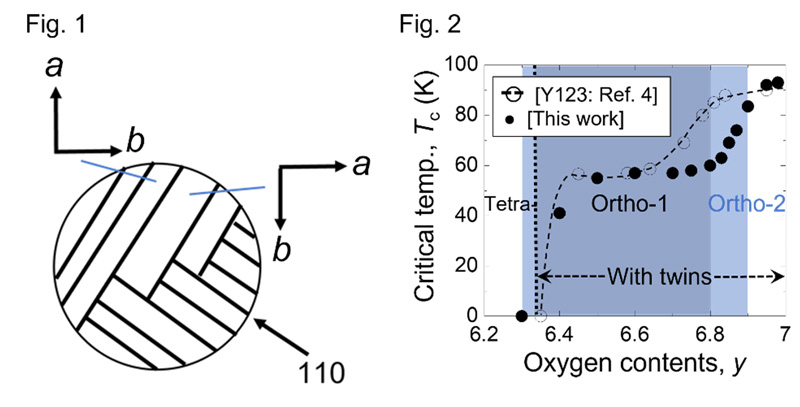PC7-7
Magnetic alignment behavior of DyBa2Cu3Oy grains controlled by annealing
Dec. 1 12:50-13:05
*Shintaro Adachi1, Ataru Ichinose2, Walid Bin Ali1, Fumiko Kimura1, Jun-ichi Shimoyama3, Shigeru Horii1
Kyoto University of Advanced Science1
Central Research Institute of Electric Power Industry2
Aoyama Gakuin University3
To achieve high self-field and in-field critical current densities in the high critical temperature (high-Tc) cuprate superconductors, densification of the crystal texture and bi- or tri-axial crystal orientation are necessary. Here we are focusing on magnetic alignment as a method for triaxial orientation of REBa2Cu3Oy (RE123) grains. By using a magnetic field, we can orient crystal grains without touching the sample. The typical advantages of magnetic alignment are the needless highly oriented templates, and it is also the room temperature process.
At the structural phase transition from tetragonal to orthorhombic, RE123 forms twin microstructures in the grain level [1]. In the RE123 grain level, the a(b) and b(a) axes are orthogonal between the two adjacent domains. Such domains are separated by the (110) plane, as shown schematically in Figure 1. Therefore, the abundance ratio of domains may determine the in-plane magnetic anisotropy in the grain level. Magnetic anisotropy in the grain level is one of the important parameters that determine the energy of magnetic alignment. Recently, we fabricated biaxially aligned samples of DyBa2Cu3Oy (Dy123) powders by magnetic alignment. The Dy123 shows a relatively large magnetic anisotropy among RE123 cuprates. Furthermore, by observing transmission electron microscopy (TEM) images of a biaxially aligned Dy123 grain, we discovered the inhomogeneous domain ratio with twin microstructures contributing to in-plane magnetic anisotropy in the grain level [2]. As a next step, we are now investigating the possibility of controlling the in-plane magnetic anisotropy in the grain level of Dy123 by applying several annealing conditions. The enhancement of the in-plane domain ratio, including the twin microstructures by the annealing, leads to the enhancement of the in-plane magnetic anisotropy in the grain level. Thus, the annealing of Dy123 may reduce the magnitude of the magnetic field for magnetic alignment.
If the magnetic alignment of RE123 can be achieved by the magnetic field due to only the permanent magnets, it will be possible to support continuous fabrication processes by using the recently developed linear drive type of modulated rotating magnetic field system [5]. The purpose of this study is to improve the in-plane magnetic anisotropy of Dy123 in the grain level by annealing. Based on the above background, we investigated the annealing conditions for Dy123.
First, we obtained Dy123 polycrystals by sintering Dy123 pellets in air at 950°C with furnace cooling. And then, we also prepared Dy123 by controlling the oxygen content y by various annealings. Figure 2 shows the oxygen content y dependence of Tc for Dy123. For comparison, the oxygen content y dependence of Tc for Y123 [4] was also plotted. Due to the difference in RE ion species, the difference was observed in y-Tc plots. Dy123 has a narrower range of y in the Tc = 90K phase than Y123. It was also suggested that Dy123 has a narrower range of y in the Ortho-2 phase than Y123. Dy123 will be in the Ortho-1 phase when the oxygen content is 6.35 < y < 6.90. A boundary between the Tetra-and Ortho-1 phases of Dy123 was also shown by the recent in-situ XRD experiment [5] to exist at y around 6.35. Based on these experimental results, we obtained Ortho-Dy123 samples from high-temperature phase Tetra-Dy123 by various annealing conditions. Ortho-Dy123 powder samples for magnetic alignment were biaxially aligned in epoxy resin under various modulated rotating magnetic fields. By solidifying the epoxy resin, the biaxially aligned Dy123 grains were fixed. Powder XRD and pole figure measurement were used to evaluate the degree of orientation of the sample.
In this presentation, we will report the details of our experimental results and discuss the relationship between the annealing conditions and the magnetic alignment behaviors of Dy123 grains.
[Acknowledgement] This work was partly supported by JSPS KAKENHI Grant Number JP17H03235
[1] R. H. Hammond and R. Bormann, Physica C 162-164, 703 (1989).
[2] S. Adachi et al., IEEE-TAS 32, 7200105 (2022).
[3] S. Horii et al., J. Cer. Soc. Jpn. 126, 885 (2018).
[4] R. J. Cava et al., Physica C 165, 419 (1990).
[5] F. Kimura et al., CrystEngComm 24, 3807 (2022).
Keywords: cuprate superconductor, magnetic alignment, modulated rotating magnetic field, twin microstructures
